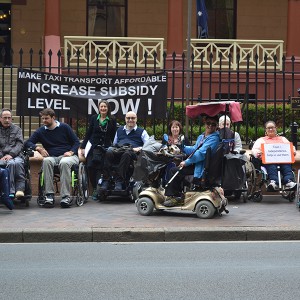 A campaign to raise the taxi transport subsidy level is gathering momentum as the NSW state election looms. The Taxi Transport Subsidy Scheme (TTSS) was introduced in 1981 when there were limited public transport options available for people with disability. The current voucher system has a maximum subsidy cap of $30, which is covered by the NSW government. It covers 50 per cent of taxi fares up to a maximum of $60 and has remained unchanged since 1999. There has been a strong move by disability support groups to increase the subsidy in line with Victoria that operates a similar system that covers 50 per cent up to a $120 fare.
A campaign to raise the taxi transport subsidy level is gathering momentum as the NSW state election looms. The Taxi Transport Subsidy Scheme (TTSS) was introduced in 1981 when there were limited public transport options available for people with disability. The current voucher system has a maximum subsidy cap of $30, which is covered by the NSW government. It covers 50 per cent of taxi fares up to a maximum of $60 and has remained unchanged since 1999. There has been a strong move by disability support groups to increase the subsidy in line with Victoria that operates a similar system that covers 50 per cent up to a $120 fare.
In a statement to F2L, the NSW Minister for Transport, Gladys Berejiklian, said the NSW Government has carried out a review of subsidies and incentives that support wheelchair accessible taxi services, including affordability and availability of the Taxi Transport Subsidy Scheme. “As part of this work Transport for NSW surveyed more than 1100 participants about their experience and a number of recommendations to improve the service for customers are now being considered.”
The Minister said access to transport was an issue taken very seriously. “That is why this government increased funding to community transport for the first time since 1998 and established the Transport Access Program to improve access to stations, wharves and bus stops across NSW.”
Greens NSW MLC Jan Barham hosted a TTSS forum at Parliament House in Sydney recently with a panel of speakers that included Greg Killeen, senior policy and advocacy officer at Spinal Cord Injuries Australia (SCIA) and Michael Simpson, general manager for client services, Vision Australia.
Killeen stressed the importance of getting the NSW Government to address these issues that can have major consequences for many people with disability using taxi services. “Apart from the social isolation, often people cannot afford to seek or maintain employment and for those living in rural areas the $30 does not cover much from each trip.” Another option put forward to the government that was rejected was that the government pay the first $30 of each trip. “So if the trip is $40 the passenger pays $10 instead of $20. It would also allow people to travel shorter distances more often,” Killeen said. Results from the NSW Government survey of 1100 participants found the average fare was $33 however in many cases this was clearly inadequate, he said. “The government needs to allocate another $25-$30 million dollars a year towards the TTSS.” Killeen also noted that Transport NSW was reluctant to move forward on an electronic card which he believed would minimise fraud that does occur with the current voucher system.
Simpson said while the introduction of the scheme has made life easier for those with disability in terms of community access, increasingly more trips are over the limit “although the administration of the scheme seems to work well.” As for the credit card approach, while this was trialled 10 years ago it became a casualty of the move to an opal type card that failed to eventuate. “Blind people have no option but to take the word of the driver to see what the fare is and we have to rely on the taxi driver to fill out the voucher.” While Vision Australia supports a review of the subsidy it was important to make sure it was indexed, he said. “For some reason there is reluctance from governments to move on increasing the levels of the subsidy whether that be up to 50 per cent of $100 or another subsidy level, you have to start somewhere.” Simpson also advocates offering TTSS users the option of the occasional longer trip instead of limiting travel to shorter distances.
The forum ended with Jan Barham making a plea to the audience to raise awareness for an issue that has not been addressed for 15 years by signing a petition on her website.
To join a petition to support an increase in the subsidy visit: http://www.janbarham.org.au/2014/10/petition-fix-taxi-transport-subsidy-scheme/
